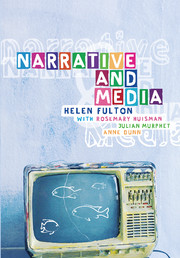Book contents
- Frontmatter
- Contents
- Figures and tables
- Contributors
- Acknowledgements
- 1 Introduction: the power of narrative
- Part 1 The basics of narrative theory
- Part 2 Film as narrative and visual mode
- 4 Stories and plots
- 5 Narrative time
- 6 Narrative voice
- 7 Point of view
- 8 Novel to film
- 9 Film narrative and visual cohesion
- Part 3 Television: narratives and ideology
- Part 4 Radio and print journalism
- Part 5 Popular print culture
- Glossary
- Bibliography
- Index
6 - Narrative voice
Published online by Cambridge University Press: 05 June 2012
- Frontmatter
- Contents
- Figures and tables
- Contributors
- Acknowledgements
- 1 Introduction: the power of narrative
- Part 1 The basics of narrative theory
- Part 2 Film as narrative and visual mode
- 4 Stories and plots
- 5 Narrative time
- 6 Narrative voice
- 7 Point of view
- 8 Novel to film
- 9 Film narrative and visual cohesion
- Part 3 Television: narratives and ideology
- Part 4 Radio and print journalism
- Part 5 Popular print culture
- Glossary
- Bibliography
- Index
Summary
The relations between narration proper and the points of view of the characters being narrated are every bit as complex as the relations between story time and ‘plot’ time. In any narrative form, there is a spectrum of what we can call ‘distances’ between a narrator's ‘voice’ and the mental and sensory states of his or her characters: from alpine and godlike superiority, through gradations of nearer proximity and outright identity to the point where the characters know more than the narrator. This spectrum of relations clearly hinges on a question of apparent ‘knowledge’, although we also know that, in some ultimate sense, the film ‘knows itself’ throughout; it produces various narrators to tantalise us with their different degrees of knowledge.
Consider for a moment the intricate patterns of knowing and unknowing in Brian Singer's Usual Suspects (1995). One principal narrator, ‘Verbal’ Kint, spins a dizzying yarn to one principal narratee, Dave Kujan. Internal to Kint's story, various other narrators tell their stories (Keaton, Kobayashi and so on). Meanwhile, external to it, Kujan interrupts with his own versions of some events, while a survivor of a mysterious waterfront atrocity is telling, in Turkish, the story of seeing Keyser Söze. By interlacing these distinct voices, Singer achieves a formidable density of narrative texture and moreover works towards his astonishing final revelation: that Kint is himself Keyser Söze, and that almost everything he has been telling Kujan (and us) is a welter of lies, fiction and misrepresentation.
- Type
- Chapter
- Information
- Narrative and Media , pp. 73 - 85Publisher: Cambridge University PressPrint publication year: 2005



